Have you ever wanted to make Tahdig Persian Rice with that perfectly crispy golden crust? This recipe and step-by-step tutorial is all you need! And I have lots of ideas for what to serve along!
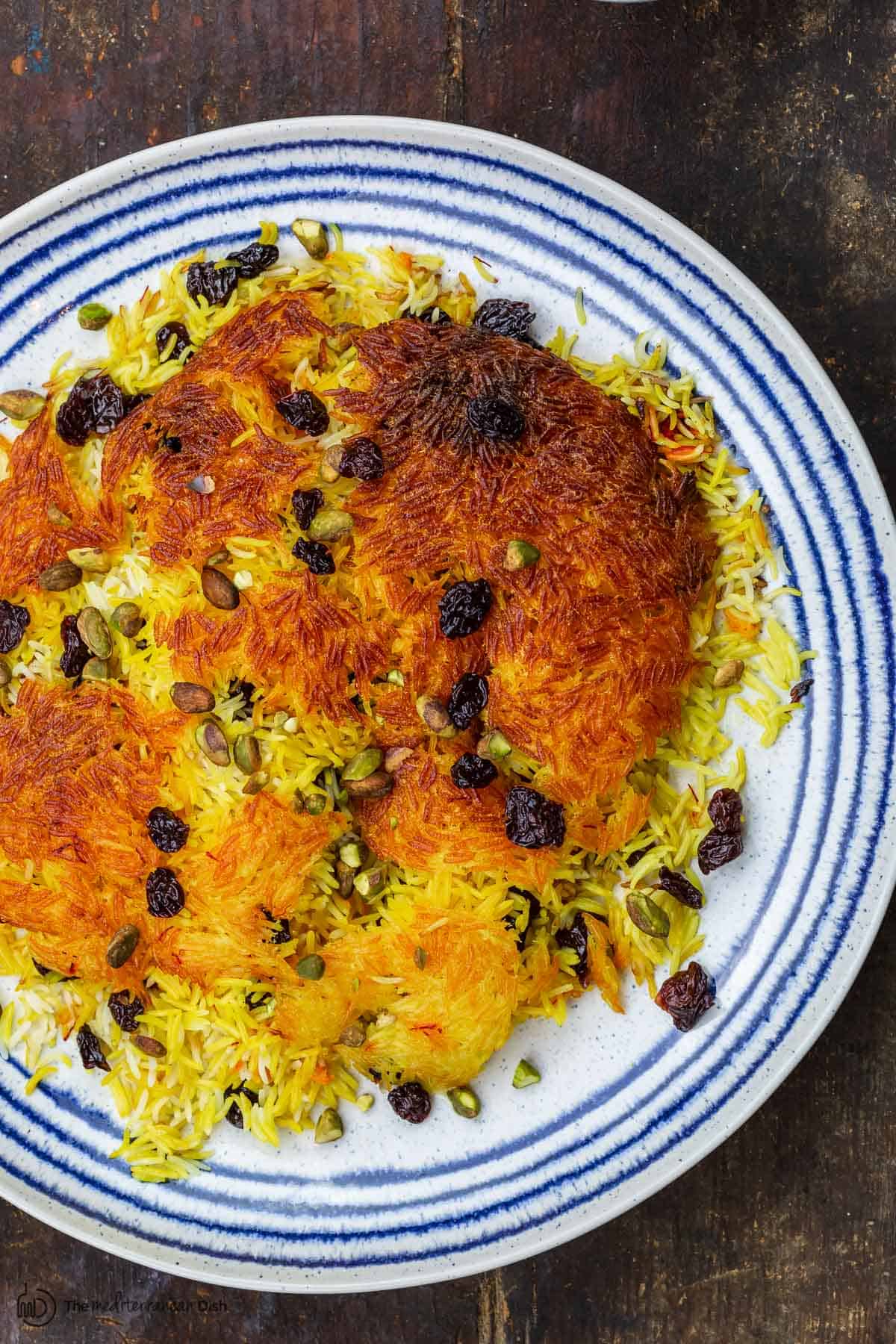
Tahdig has been on my list to make for while. And I’m happy to report it is easier to make than I thought! And if you ever wanted an impressive and unique dish for a special dinner, this Persian style rice with golden crust will not disappoint.
I adapted and simplified a recipe from Eden Grinspahn’s cookbook Eating Out Loud, and once you try this easy Persian rice recipe you will come back for more!
What is tahdig?
Tahdig, pronounced tah-deeg, literally means “bottom of the pot” in Persian/Farsi. And it refers to a beautiful, pan-fried Persian rice that is fluffy and buttery on the inside with a perfectly golden crust, which is the layer at the bottom of the pot. It’s beautifully laced with saffron and often scented with orange zest like in today’s recipe.
In her new book Eating Out Loud (affiliate link), Eden describes making tahdig this way:
You’re basically building a rice “cake” with layers of rice, yogurt, and butter. It gets cooked in a tightly covered pan, where the steam cooks the rice while the outside crisps. Then it’s turned upside down out of the pan on a platter, where–if you’ve done your job right–the crispy outside bits hold the moist inside like a mold.
Tip: Don’t be a hero, use a nonstick pot. Makes all the difference!
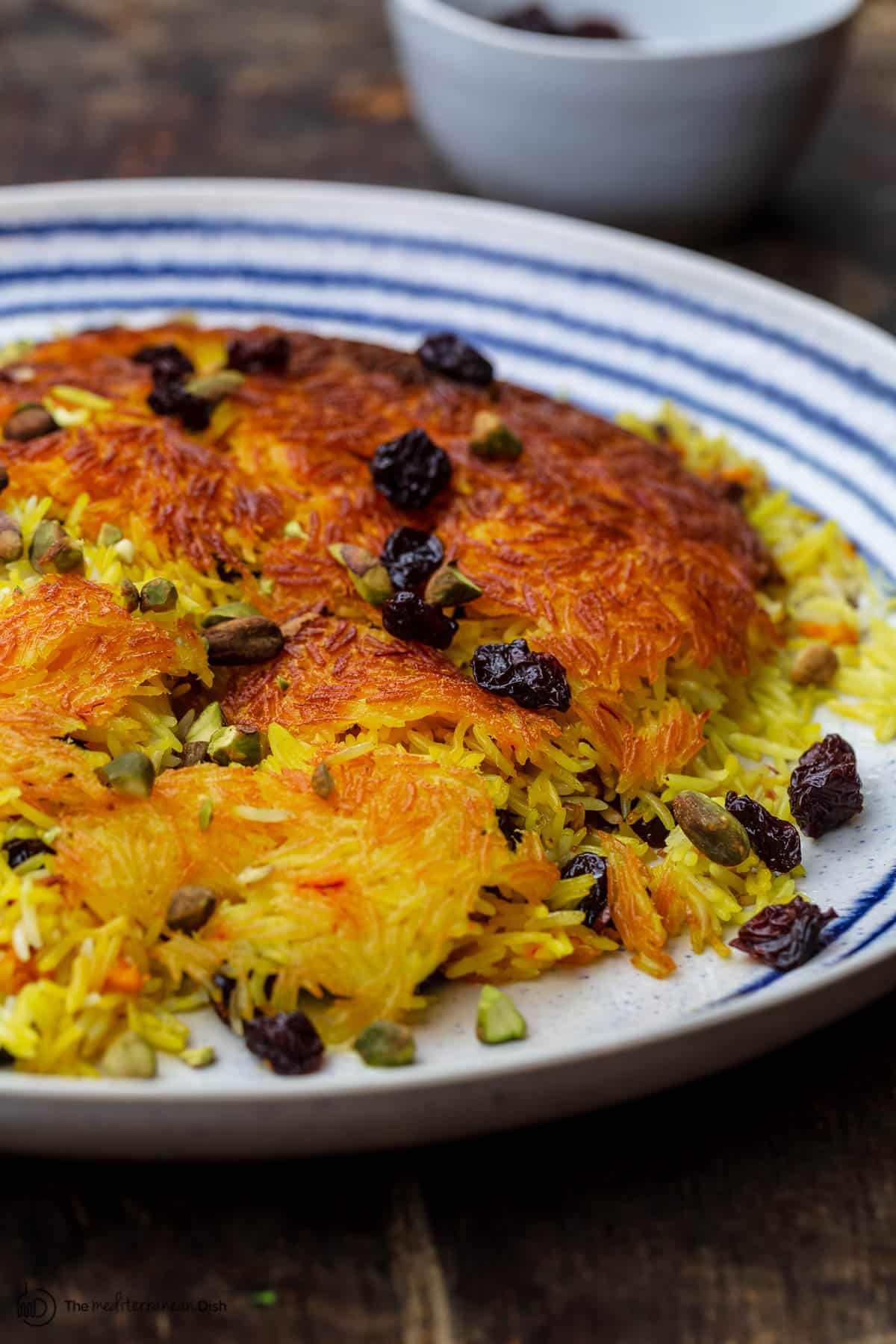
What kind of rice to use for Persian rice?
The kind of rice used is important. My Iranian friends only use Basmati rice (affiliate) for this recipe and all their Persian rice dishes, including Adas Polo, with lentils and raisins, and Baghali Polo, with fava beans and fresh dill.
Two steps to prepare the rice for this tahdig recipe:
- Wash the basmati rice very well under cold running water until the water runs clear. Some folks even soak it for a bit, but that is not required today.
- Par-boil the rice. You’ll boil the rice with plenty of water and cook to al dante for 5 minutes or so before you assemble and make the tahdig.
The crust
The crust is where it’s at! It’s what makes this Persian rice recipe extra special.
What makes the crust? There are different tahdig variations when it comes to acheiving that perfectly crispy, golden crust. Some use a layer of flat lavash bread at the bottom of the pot, while other recipes may use a layer of thinly sliced potatoes. But it’s the third method I wanted to try…
In this recipe, the curst is made of a mixture of rice, whole milk yogurt, and saffron. The extra fat from just two tablespoons of whole milk yogurt really helps the bottom layer of rice crisp up nicely, while the above layer of rice gets steamed to fluffy perfection.
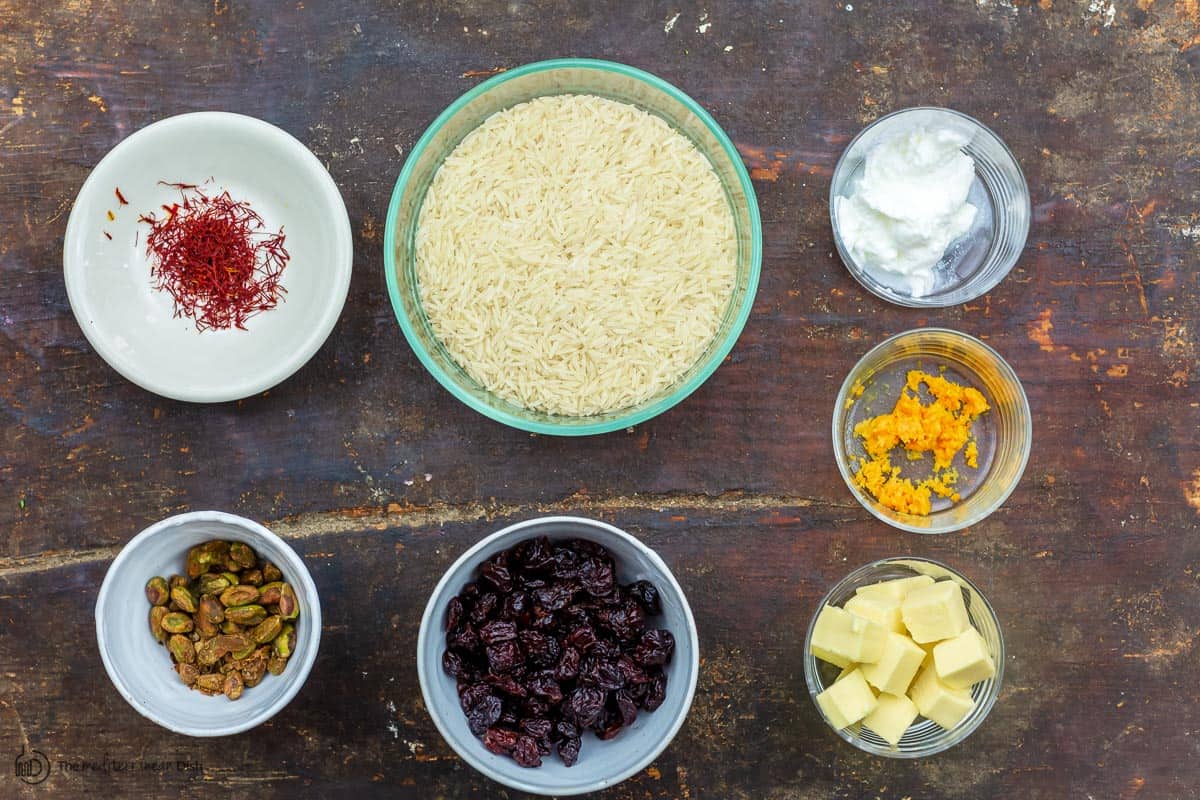
How to make tahdig: step-by-step
(print-friendly recipe with ingredient list below)
- Soak the saffron. 1 teaspoon of saffron goes in 1 cup of super warm water (but not hot). Leave it be for at least 10 minutes. It’s important to give the saffron enough time in the water to bloom and release it’s beautiful color, so that’s why I start with this step.
- Wash the rice and boil the rice. Like I mentioned earlier, you’ll want to wash 2 cups basmati rice so well until the water runs clean. Then combine the rice with 8 cups of water and a good pinch of salt (the original recipe calls for 2 tablespoons as this is your only shot to season the rice itself, but I used 1 tablespoon). Boil for about 5 to 6 minutes, then drain well.
- Prepare the rice, yogurt, saffron mixture. Take 1 cup of the rice and mix it super well with 2 tablespoons of yogurt, 2 tablespoons of grapeseed oil (or another neutral-tasting oil) and 2 tablespoons of the saffron water.
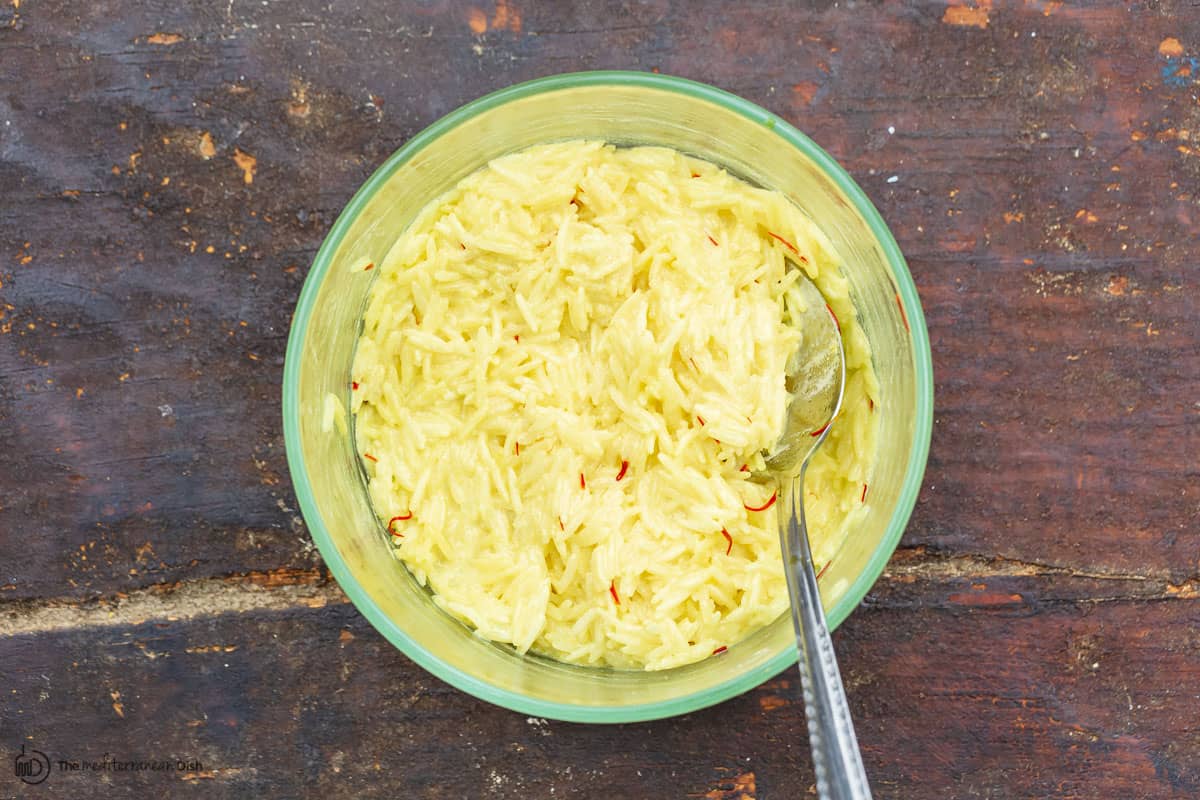
- Assemble the tahdig in a nonstick pot. Spread the rice-yogurt mixture in bottom of the pot (this is what makes the crust). Use a 10-inch lidded nonstick pot here. Add 1 cup of the remaining rice on top, then 2 tablespoons of dried cherries, a little orange zest, and a pinch of cinnamon. Continue layering in this way until you have used up the rice (keep some of the dried cherries for garnish later). Dot the top layer o rice with the butter (the original recipe called for 8 tablespoons of butter, cubed, but for us 4 to 5 tablespoons was sufficient). Pour the rest of the saffron water on top.
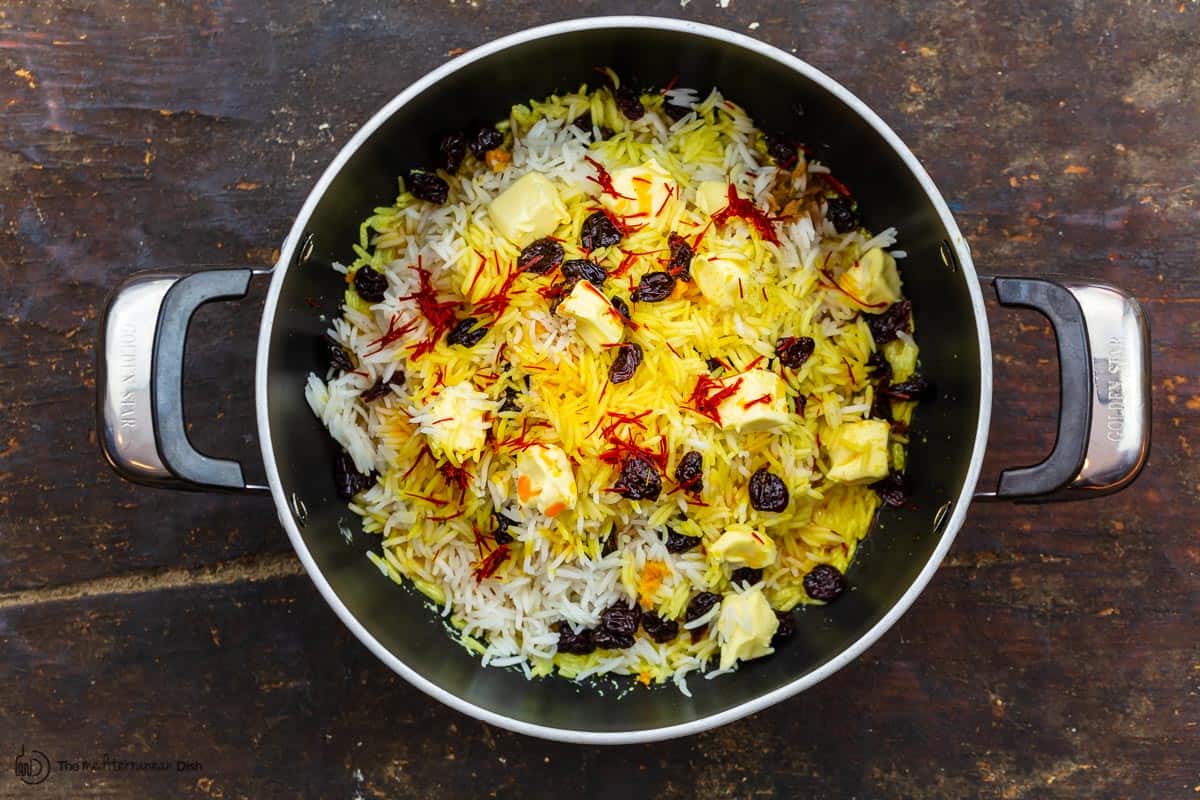
- Cook the tahdig. To really trap the steam, do as my Persian friends do, wrap the lid of the pot in a thin kitchen towel. Use a rubber band to secure the towel around the handle (a little safety measure). Cover the pot and cook over low heat, 25 to 30 minutes or until the rice around the edges is golden and crispy (mine took more like 50 minutes for the bottom layer to fully crisp up and fully develop the golden color you see. I also ended up raising the heat a little bit to medium-low for a bit). Keep an eye and peek under the lid to make sure the bottom layer crisps nicely but does not burn (this is really all the TLC you need to do and it makes a difference).
- Flip the cooked tahdig over and serve. Remove the lid from the cooking pot and invert a large serving platter over the pot and carefully flip the pot over (the bottom crispy layer will now be on top). Although the nonstick pot helps a ton, don’t worry if some of the rice sticks to the bottom, just help it with a wooden spoon and run with it! Garnish with dried cherries and pistachios. Serve!
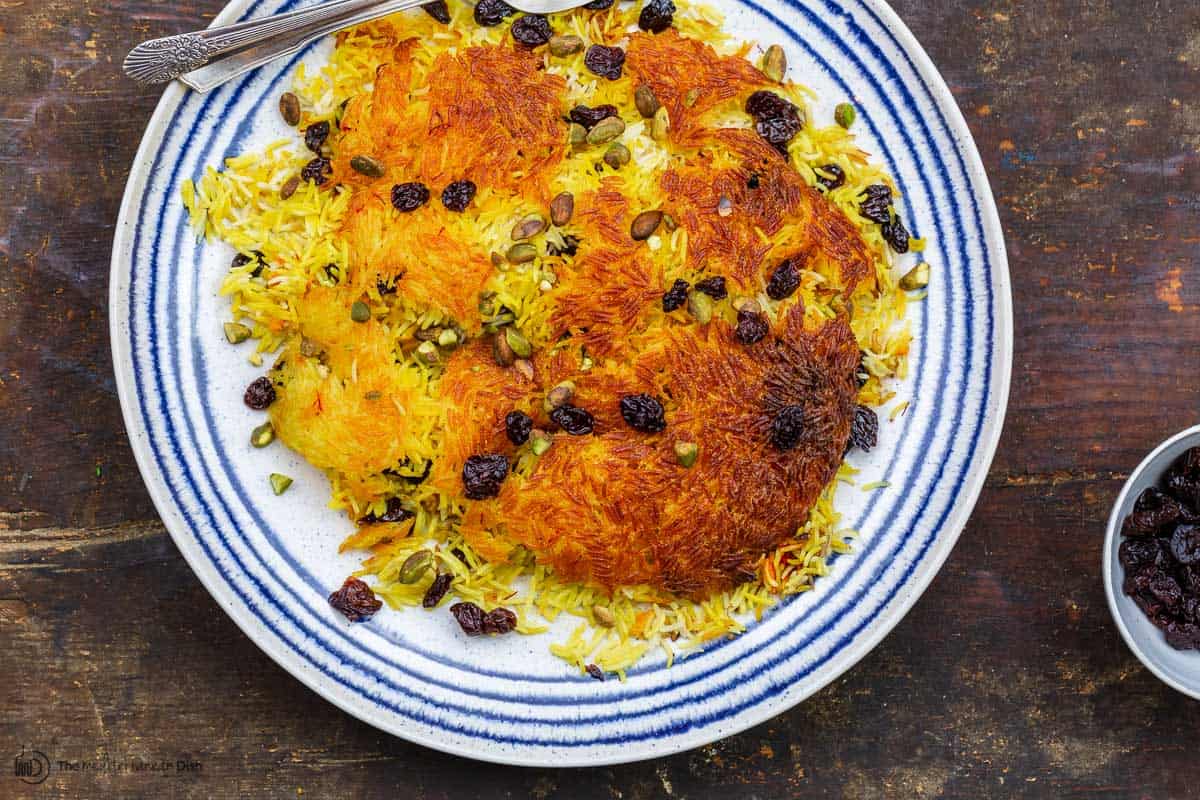
- Serve. Remove the lid, invert a large serving plate over the pot, and carefully flip them over together. No worries if it sticks, just scrape it out and run with it! Sprinkle the tahdig with the reserved dried cherries and pistachios and serve right away.
What to serve with tahdig?
This crispy saffron rice can elevate any number of entrees. Here are some ideas for what to serve along:
- Hearty stews. I don’t have any Persian stew recipes yet, but I can recommend this Moroccan lamb stew; vegetable tagine; or even roasted cauliflower and chickpea stew
- Saucy fish stew like this fish shakshuka. Or fried fish like pan seared trout.
- Roasts etc. like Spatchcock chicken; baked chicken drumsticks; boneless leg of lamb; lamb shanks
- Grilled Meats. Beef Kabobs; Kofta; Chicken Kabobs; Grilled Whole Chicken; or Lemon Chicken are all great options.
Craving more? Check out all our Mediterranean recipes. Browse our Top 50 Mediterranean Diet Recipes.
JOIN MY FREE E-MAIL LIST.
Tahdig Recipe (Crispy Persian Rice)
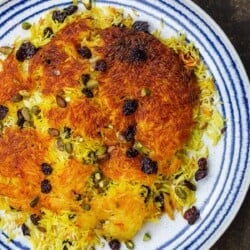
Ingredients
- 1 tsp saffron threads
- 2 cups basmati rice like Royal Basmati Rice (affiliate link)
- 1 to 2 tbsp Kosher salt
- 2 tbsp whole milk yogurt (Greek or otherwise)
- 2 tbsp grape seed oil, or any healthy neutral-tasting oil of your choice
- 1 cup dried cherries, finely chopped
- Grated zest of 1 orange
- 1/2 teaspoon ground cinnamon
- 4 to 8 tbsp unsalted butter, cubed (see note #1)
- 3 tbsp pistachios, roughly chopped for garnish
Instructions
- Mix the saffron into 1 cup very warm (but not hot) water. Let sit for at least 10 minutes to let the saffron release all of its flavor.
- In a sieve, rinse the rice under cool running water until the water almost runs clear.
- In a large pot, combine 8 cups of water and the salt (this is your one shot to season the rice itself). Bring to a boil over medium-high heat. Add the rice and cook until al dente, 5 to 6 minutes. Drain the rice.
- In a medium bowl, combine 1 cup of the cooked rice, the yogurt, grapeseed oil, and 2 tbsp of the saffron water. Mix thoroughly.
- Spread the rice-yogurt mixture evenly on the bottom of a 10-inch lidded nonstick pot. Sprinkle 1 cup of the remaining cooked rice on top, followed by 2 tablespoons of the dried cherries, a pinch of orange zest, and a pinch of cinnamon. Add another layer of rice and repeat with the cherries, orange zest, and cinnamon, reserving a couple tbsp of the cherries for garnish. As you go about layering, the rice will start to dome and look "pointy" in the middle--that's okay! Keep it that way. Finish by dotting the top with the butter and pour the rest of the saffron water all over the top.
- Wrap the lid in a kitchen towel and secure it around the handle with a rubber band. Cover the pot and cook over low heat, 25 to 30 minutes or until the rice around the edges is golden and crispy; it's okay to peek under the lid! (See note #2) Be sure not to burn the bottom layer of the rice, though you do want a nice crust in the bottom.
- Remove the lid, invert a large serving plate over the pot, and carefully flip them over together. No worries if it sticks, just scrape it out and run with it! Sprinkle the tahdig with the reserved dried cherries and pistachios and serve right away.
Notes
- This recipe is adapted from Eating Out Loud (affiliate link) by Eden Grinchpan.
- I used Royal Basmati Rice (affiliate link)
- Note #1--butter amount: The original recipe indicates 8 tablespoons (or 1 stick) unsalted butter. For me, 4 to 5 tablespoons were sufficient.
- Note #2--how long until the bottom layer of rice crisps will vary. My rice took 50 minutes for the bottom layer to crisp, and I did adjust the heat later to medium-low. It's important to keep an eye on the rice and peek under the lid occasionally to make sure the bottom crisps but does not burn.
- Visit our shop for quality Mediterranean products including extra virgin olive oils and spices.
Nutrition
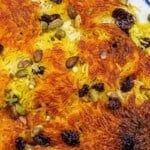
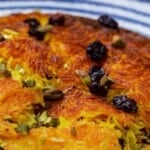
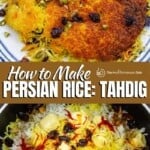
This. recipe looks and sounds delicious. I would share this recipe with our family.
This looks interesting! I’ve never heard of this dish before.
Can hardly wait to try this recipe and share with my husband. He loves to try new foods!
We have an Iranian chef who teaches cooking classes at our local specialty store, The International Pantry and he makes this for us every class season. He calls it Wedding Rice. Love this recipe!
This Tahdigsounds fab! Can’t wait to try it. We’ve been on the Mediterranean diet for two years and learned so much from you, Suzy! Thanks!
That’s wonderful, Larry! Thank you!!
Looks yummy! Cant wait to try it. Love all your recipes
Thanks, Nicole! Enjoy!
I have been wanting to make Tahdig ever since a Persian friend cooked it for me in their home. So warming and delicious. Can’t wait to try!
Hi Suzi,
I am a big fan of your recipes. My Persian blood made me want to share this with you. Thanks so much for all the amazing food
Aww! Thanks so much, Afsaneh!
My husband’s dietary restrictions make this a no-no in my house, but this looks amazing. I’m forwarding it to my daughter. 🙂
I have so wanted to try this dish…..you have inspired me….I have all the ingredients now to get going…thanks
Wonderful! Hope you love it!
I will share this with my sister Trish.
Dear Beautiful Suzy,
Your Mediterranean recipes are the best. Healthy, tasty, and attractive to present on the table.
Thank you.
Thank you, George!
Greetings! Your recipes are so delicious!! Really looking forward to trying this one. I’m following WW’s purple program, which makes brown rice zero points, so where possible I use brown rice instead of white. Can I use brown basmati rice here? Any differences in cooking time, ingredients or other considerations? Thank you!
Wow! I will agree with Cindy. I always appreciate the step-by-step photos and careful explanation. I can’t wait to share this recipe with my family.
Enjoy!
I am so THRILLED! Super excited to finally have a good tutorial for how to make tahdig. I’ve wanted to make it for a long while now. Thanks so much for sharing.
So glad, Cindy! Thank you
Can’t wait to try!